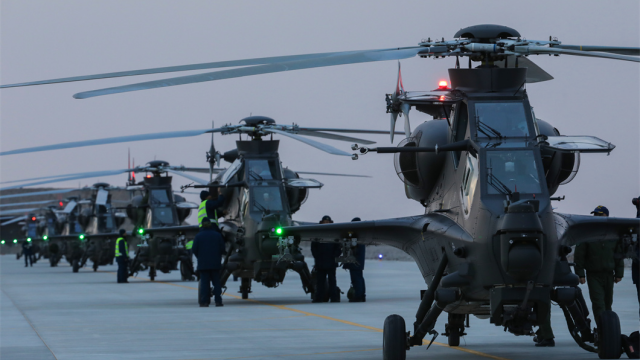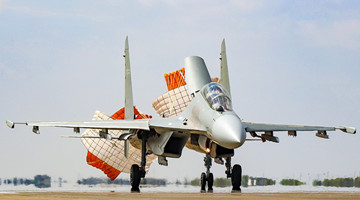
Russian military officers and soldiers participating in the “Vostok-2018” strategic military drills are conducting rope-rappelling from a helicopter at the Tsugol training range in Russia’s Trans-Baikal Region. (Published by Xinhua News Agency)
Recently, Russian Defense Minister Sergei Shoigu conveyed the priorities of this year’s military development approved by Russian President Vladimir Putin at the National Defense Control Center (NDCC) in Moscow.
Background – Growing domestic economy and grim picture of global security situation
Influenced by both domestic and international factors, the five priorities for development proposed by Russia are important measures to accelerate the modernization of its armed forces.
Domestically, the three-stage Russian military development starting in 2008 has been greatly hindered by the economic crisis and Western sanctions. In view of this, the focus and highlight of Russia’s military construction in 2019 are to speed up the upgrading of weapons and equipment and to commission new weapons in order to achieve the 70% share of modernized equipment to the total in Russia military by 2020. The positive economic growth in 2018 has also created favorable condition to support Russia’s defense budget increase and procurement.
Internationally, the world security situation has been severe since the Ukrainian crisis at the end of 2013, and relations between Russia and the West have remained tense. The United States' unilateral withdrawal from the Intermediate-Range Nuclear Forces (INF) Treaty has greatly impacted the international strategic stability. Furthermore, the hybrid warfare, cyber warfare and information warfare in Syrian military operations have also brought new requirements for Russian combat ideology and equipment development. Russian President Putin has clearly pointed out, “Russia must put the development of digital technology equipment, artificial intelligence, drones and robot systems on its agenda in terms of Russian military construction.” Comprehensively modernizing the armed forces is the only way for Russia to effectively deal with new military threats and win modern wars.
Contents - Five priorities in development
Firstly, Russia will focus on the development of nuclear and aerospace defense forces, with a view to improving its strategic deterrence. Russia will continue to strengthen its “triad” strategic nuclear power comprising the land-based, sea-based and space-based forces. In terms of land-based nuclear forces, Russia will upgrade its active intercontinental ballistic missiles (ICBMs) and realize the replacement of the Yars missile system deployed. For sea-based nuclear forces, the first Borey-A-class strategic nuclear submarine Prince Vladimir, equipped with Bulava submarine-launched ballistic missiles (SLBMs), will be commissioned to Russian naval fleets. For space-based nuclear forces, the Russian Aerospace Forces will upgrade the Tu-160 and Tu-95MS long-range bombers carrying strategic missiles. For air defense and anti-missile forces, apart from the continuous deployment of the S-400 air defense missile system, the Russian military will also step up the development of the S-500 air defense missile system. By 2019, two regiments of the Russian Aerospace Forces will be equipped with S-400 air defense missile systems, while the S-500 air defense missile system is scheduled to be commissioned by 2020.
Secondly, Russia will speed up the updating of military equipment and improve its national defense procurement system. According to The State Armaments Programme for 2018-2027, Russia will invest 19 trillion rubles (about 306 billion US dollars) in the next 10 years in defense procurement and equipment upgrades. In 2019, Russia will invest 1.44 trillion rubles (about 21.4 billion US dollars) to implement its equipment procurement plan, of which about 71% will be used to purchase new weapons. Russia aims to reach the percentage of 67% modernized weapons in total by the end of 2019, and 70% by the end of 2020 respectively. In 2019, the Russian military will install more than 1,800 pieces (sets) of weapons and equipment, and repair approximately 1,500 pieces (sets). Meanwhile, Russia will continue to improve its national defense procurement system, boost the scientific and technological levels and support capabilities of its national defense industry, attract private enterprise investment, and accelerate the development of military-civilian integration.
Thirdly, Russia plans to increase its military training to improve the troops’ combat capabilities. With the goal of highlighting the actual combat effects and improving the actual combat skills of the military, the Russian military will strengthen the actual combat training. As the Russian Defense Minister Sergei Shoigu once said, the Russian military has recruited well-trained professionals, and almost all commanders at the brigade and regiment levels have actual combat experience. In 2019, the Russian military intends to plan and conduct a total of 18,500 war games and trainings, including the strategic exercise “Tsentr-2019” and the strategic nuclear power exercise “Global Thunder”, as well as the Russia-Belarus joint exercise “Union Shield-2019”.
Fourthly, In order to improve joint operation capabilities of multiple services, Russia tends to actively develop command, communication, reconnaissance and electronic warfare systems. The Russian military will reorganize and re-equip its airborne troops to enable them to carry out global strikes. In addition, Russia will also modernize the existing technologies and equipment to improve the information acquisition and space combat capabilities of the Russian Aerospace Forces. The Radio-Technical Troops (RTT) of the Russian Aerospace Forces will be equipped with 80% modern radar system and 100% automatic equipment system before 2020. Russia will also actively develop drone technical equipment and artificial intelligence systems. At present, there are more than 1,900 unmanned aerial vehicles (UAVs) in service. The UAV project under way includes the development of a new-generation dual-use drone “Pirate”, and a new-generation jet-propelled stealthy drone “Hunter”, etc.
Fifthly, Russia will actively carry out international military exchanges and cooperation to exert influence from the following aspects. First of all, Russia will promote the establishment of a unified missile defense system for the members of the Collective Security Treaty Organization (CSTO). Russia has deployed a unified missile defense system in areas near Armenia , Belarus, and Kazakhstan, and has expanded the deployment of regional missile defense system in Central Asia including Tajikistan and Kyrgyzstan. Secondly, Russia will continue to develop and expand its military cooperation with India, Turkey, Vietnam and other countries. Russia will offer S-400 air defense missile systems to Turkey in 2019 and will cooperate with it in terms of aeronautical equipment and engines. Thirdly, Russia will hold military exchanges such as the Moscow Conference on International Security and the International Military Games on a regular basis.
(The author is Zhang Wenru from National University of Defense Technology (NUDT).)









